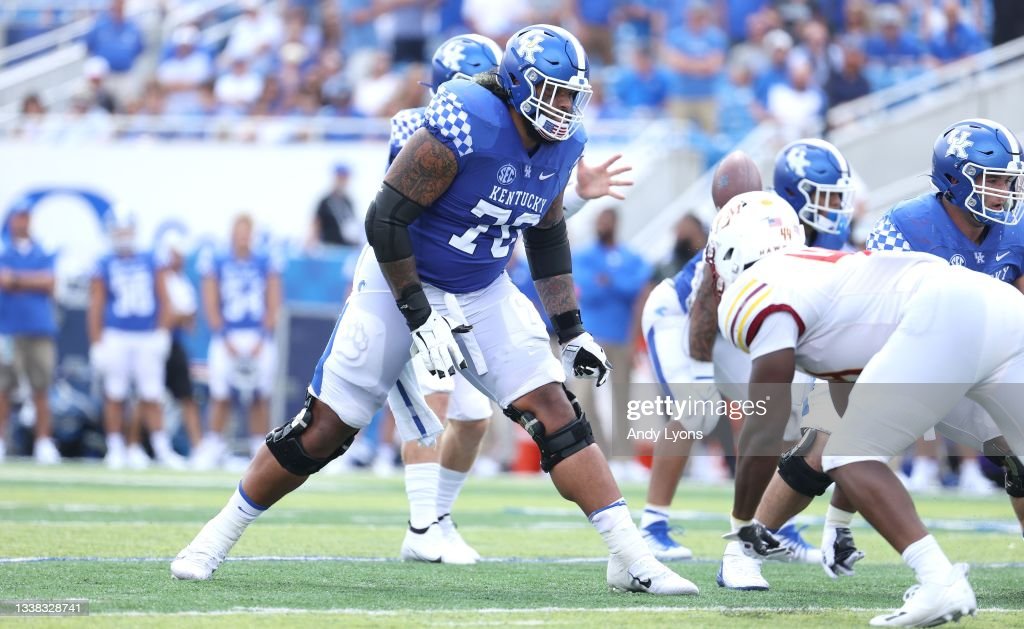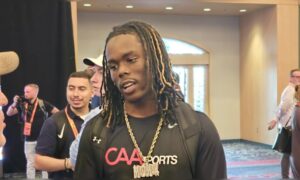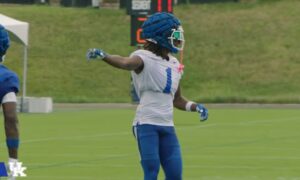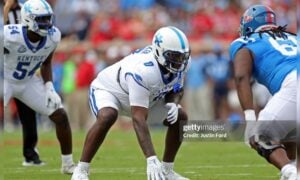From now until the 2022 NFL Draft takes place, we hope to scout and create profiles for as many prospects as possible, examining their strengths, weaknesses, and what they can bring to an NFL franchise. These players could be potential top 10 picks, all the way down to Day 3 selections and priority undrafted free agents. Today, I’ll be profiling an offensive line prospect that has been a fixture for Kentucky for the last three seasons at right tackle but may be best suited to kick inside at the next level.
#70 Darian Kinnard, OL, Kentucky (Sr.) – 6053, 322 lbs.
Measurements
Senior Bowl/Combine Invite
| Player | Ht/Wt | Hand Size | Arm Length | Wingspan |
| Darrian Kinnard | 6053/322 | 11 1/4” | 35” | 83 1/4″ |
| 40-Yard Dash | 10-Yard Dash | Short Shuttle | 3-Cone | |
| 5.31 | 1,82 | 4.96 | 8.11 | |
| Broad Jump | Vertical | Bench Press | ||
| 8’3″ | 25 | N/A |
The Good
— Has the length and size you look for in an NFL offensive lineman
— Has the long arms to engage defenders immediately on the snap of the ball to keep him off his frame
— Possesses that thick build to impose his will as a blocker on his opposition, generating force when moving forward
— Plays with an aggressive demeanor as a run blocker looking to displace defenders across from him
— Has vice grip hands that latch onto opponents when he makes contact and will neutralize them if he connects
— Effective down blocker that also can kick out defenders toward the sideline
— Plays with his shoulders low out of his pass set, not exposing his chest to edge rushers
— At his best when allowed to quick set pass rushers and get his long arms on them early as the aggressor
— Has experience playing both guard and tackle at the college level
The Bad
— Isn’t the most fleet-of-foot when it comes to his pass sets or when asked to move laterally
— Functional athleticism appears to be limited in terms of flexibility and ability to climb to the second level
— Isn’t fluid enough of an athlete to effectively pick up defenders in space
— Footwork is poor in terms of technique as well as foot quickness
— Balance can be an issue as he ends up on the ground a fair amount of time on the ground
— Likes to lunge/lean forward on his blocks, leading to whiffs and occasional losses to counters
— Punch in pass protection as well as in the run game can be erratic, needing to be more consistent landing on the defender’s chest
— Tends to grab outside the defender’s shoulders rather than inside the defender’s chest
— Will play with a low carriage with his hands and not sync up his hands and feet with his punch regularly
— Fails to sustain blocks outside of initial punch far too often for comfort
— Can be lackadaisical with his anchor and hip bend, being susceptible to counter moves as well as straight power when he gets high in pass pro
— Uses more of a shuffle step in pass protection than a clean kick step
— Will stand nearly straight up in pass protection, leaving him at risk of getting driven back by power or limit his ability to mirror the rush
Bio
— Senior prospect from Knoxville, TN, born in Youngstown, OH
— Born December 29, 1999 (Age 22)
— Relocated during his youth and played at the powerhouse St. Ignatius program in Cleveland in high school
— Rated a four-star by ESPN and a three-star by Rivals
— All-State player in Ohio and was selected to play in the U.S. Army All-American game
— Slimmed down when he entered college, reportedly weighing 357lb in high school
— Played in nine games, starting two of the last three at left tackle as a true freshman
— Started in all 13 games at right tackle as a sophomore where he recorded 32 knockdowns during the season and had only one penalty in 706 snaps
— Started in all 11 games in 2020 where he graded at 87.4% via Pro Football Focus with 47 knockdowns
— Won the Jacobs Blocking Trophy as the best blocker in the SEC as a senior where he started all 13 games and registered 30 knockdown blocks while PFF evaluated him as one of only three Power Five tackles to grade at 85 or better as both a run and pass blocker
— Frequent visitor at Lexington VA Hospital for service work
— Kinesiology Major that looks to train athlete after his playing days in the league
— Recognized as a team captain in 2021
— Finished his college career with 39 consecutive starts while playing in 46 games
— Consensus First Team All-American in 2021, two-time First Team All-SEC (2020 & 2021), Second Team All-American (2020)
Tape Breakdown
Darrian Kinnard has been a mainstay for the Wildcats offensive line since he arrived on campus, starting the last two of his freshman season before logging 37-straight starts thereafter. He was a highly sought-after recruit out of high school, coming out of the Cleveland area after spending his early years in Knoxville Tennessee. The big-bodied blocker ended up slimming down as he transitioned to the college setting dropping nearly 30lb as he spurned his Tennessee roots to go play ball in the Bluegrass State for the conference-rival Wildcats.
When you watch Kinnard on tape, the thing that immediately sticks out to you is his aggressiveness as a blocker, especially in the run game. He has the big frame and strength to moved defenders from Point A to Point B, clearing running lanes for Kentucky’s run-heavy system. Kinnard displays his strength and mauler mentality here on this down block on Georgia’s #99 Jordan Davis, double teaming him with the RG by attacking his right shoulder and walking him back to clear a running lane. The back gets bottled up in the backfield by the rest of the defense, but Kinnard and the guard get the job done moving the nose tackle off his spot.
Kinnard brings a certain nastiness to the offensive line that you love to see, looking to put defenders on the ground and finish on top of them for the pancake block. Just a few plays later in the same game we see Kinnard take on the 5-technique defensive lineman on his outside shoulder, taking him and shoving him across his face to the ground with the aid of the TE, tossing him down and finishing on top of him for good measure.
We see a similar sight here on this clip against South Carolina where Kinnard climbs to the second level to pick up the linebacker on the option keep by the running back in the wildcat, initially getting his outside the defender’s shoulders but replaces back inside and runs him back and eventually plants him flat on his back.
Kinnard has great size and length, possessing the reach to keep potential pass rushers at bey. Here against Georgia, we see Kinnard get his hands on the defender quickly after the snap, extending his arms and stalling the rush.
Despite having great length, Kinnard doesn’t possess the foot quickness to set the depth of the pocket against speed rushers coming off the edge. Watch this rep against #1 Brenton Cox of Florida, who runs right past Kinnard’s outside shoulder for the sack.
Not only does Kinnard struggle with heavy feet in pass protection, but he also plays with erratic hand placement on his punch. Watch this rep against South Carolina where he starts off in good position against the defender, but grabs outside his shoulder pads, being unable to neutralize the pass rusher who counters back inside and gets in on hitting the QB.
This rep encapsulates the technical flaws Kinnard deals with in pass protection well. He gets an initial good step out of his stance on the snap but keeps his hands down to his size rather than up and at the ready to punch. His pass set looks choppy, having more of a gallop step than a traditional vertical pass set. When he finally makes contact with the defender, he drops his head into his chest and grabs the defender around his waist, missing his strike zone. The defender starts to work across Kinnard’s face in pursuit of the ball, and Kinnard ends up hooking the defender for the holding call.
Kinnard likes to plow people over in the running game, having that mauler mentality. However, he often plays too far over his base with his pads, lunging forward into blocks with his head down, thus leading to balance issues and whiffed blocks like we see on this rep against the Gamecocks where Kinnard goes into his block with his down and again hands outside, shortly falling off and ending up on the turf.
We see another example from earlier in the game against another NFL Draft hopeful #1 Kingsley Enagbare. Kinnard takes a sidestep to the left to cut off the angle of pursuit to the ball, but when he throws his punch on Enagbare, he shoots his shoulders forward over his base and drops his head down, giving the edge defender the ability to shed the block. Kinnard saves the play by falling into Enagbare’s legs, eventually falling to the turf as the defender gets off the cut block attempt, but just misses catching the back who scores. It wasn’t a complete loss for Kinnard, but the lack of technique shows up frequently in his wins as well as his losses.
Here another example from Senior Bowl practice of Kinnard again ducking hi head and leaning into his attempted pass block, falling off almost immediately on the spin move by #99 Eric Johnson who gets by him easily to win the one-on-one rep.
Conclusion
Overall, Kinnard is a big, physical masher that does his best work when asked to move the across from him from Point A to Point B in the run game. He possesses the length and size you look for in a prototypical NFL offensive tackle but lacks the functional athleticism and mobility to hold up consistently at tackle. Kinnard has noticeable issues with stiffness and playing heavy footed along with inconsistent pad level and erratic hand placement, making him a likely liability in pass protection against NFL-caliber pass rushers coming off the edge. Because of this, Kinnard would be best suited kicking inside to guard where he can play in a phonebooth in close quarters rather than expose his poor lateral movement and foot quickness.
Many in the draft media have floated Cody Ford for the Buffalo Bills as a pro comp for Kinnard given their play style, and while I recognize the similarities, I see Ford having better hip and knee bend along with better footwork to mirror defenders while working laterally. A better comparison I came up with is current Packers OL and former NDSU Bison Billy Turner who too played RT in college before kicking inside to guard at the next level. He has played tackle on occasion in the NFL, but that has come with a mixed bag or results like the struggles Kinnard deals with.
As far as comparisons go, Turner and Kinnard are nearly identical size and length, being higher-cut offensive linemen that line to get a little to upright at times and can struggles with foot quickness and hand placement but are capable run blockers that look to create a big push upfront against their competition. Turner was drafted in the third round of the 2014 NFL Draft, and I can see Kinnard going in the same range as that Late Day Two to Early Day Three player that has notable limitations as an athlete but has a fair amount of experience and offers some positional versatility given that he goes to a gap/power running scheme where he doesn’t have to pass protect a majority of the time.
Pittsburgh could be interested in Kinnard given their recent Kentucky ties, having selected Benny Snell Jr. and Bud Dupree in recent seasons. However, unless they don’t address interior OL early, I would personally pass on Kinnard as a tackle prospect and look at him more inside at guard should they address other positions of need with their earlier draft capital. When I met with Kinnard at the Senior Bowl, he mentioned that he hadn’t spoken to the Steelers while mentioning that could change at the NFL Combine. Kinnard could bring a physical demeanor to bolster the running game the Steelers so badly need to improve, but his inconsistent work and technique in pass protection limits his overall upside as a prospect.
Projection: Late Day Two to Day Three
Depot Draft Grade: 7.6 – Potential Starter/Good Backup (4th Round)
Games Watched: at South Carolina (2021), at Georgia (2021), Senior Bowl (2021) at Florida (2020)
s, At Baylor, Vs Iowa State, Vs Oregon








